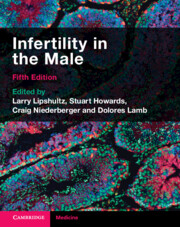Book contents
- Infertility in the Male
- Infertility in the Male
- Copyright page
- Contents
- Contributors
- Foreword
- Abbreviations
- Introduction
- Section 1 Scientific Foundations of Male Infertility
- Chapter 1 Anatomy and Embryology of the Male Reproductive Tract and Gonadal Development, the Epididymis, and Accessory Sex Organs
- Chapter 2 Cellular Architecture and Function of the Testis
- Chapter 3 Maturation and Function of Sperm
- Chapter 4 The Male Reproductive Endocrine System
- Chapter 5 Erection, Emission, and Ejaculation
- Chapter 6 Genomics, Epigenetics, and Male Reproduction
- Section 2 Clinical Evaluation of the Infertile Male
- Section 3 Laboratory Diagnosis of Male Infertility
- Section 4 Treatment of Male Infertility
- Section 5 Health Care Systems and Culture
- Index
- References
Chapter 6 - Genomics, Epigenetics, and Male Reproduction
from Section 1 - Scientific Foundations of Male Infertility
Published online by Cambridge University Press: 08 July 2023
- Infertility in the Male
- Infertility in the Male
- Copyright page
- Contents
- Contributors
- Foreword
- Abbreviations
- Introduction
- Section 1 Scientific Foundations of Male Infertility
- Chapter 1 Anatomy and Embryology of the Male Reproductive Tract and Gonadal Development, the Epididymis, and Accessory Sex Organs
- Chapter 2 Cellular Architecture and Function of the Testis
- Chapter 3 Maturation and Function of Sperm
- Chapter 4 The Male Reproductive Endocrine System
- Chapter 5 Erection, Emission, and Ejaculation
- Chapter 6 Genomics, Epigenetics, and Male Reproduction
- Section 2 Clinical Evaluation of the Infertile Male
- Section 3 Laboratory Diagnosis of Male Infertility
- Section 4 Treatment of Male Infertility
- Section 5 Health Care Systems and Culture
- Index
- References
Summary
The definition of male infertility is the inability of a male to impregnate a fertile female. Infertility is a worldwide problem and, according to Sharlip et al., affects around 15 percent of couples [1]. Based on different studies, approximately 20–30 percent of infertility cases are due to male problems, 20–35 percent due to female problems, and 25–40 percent due to combined problems in both parts, while in 10–20 percent of cases, no causes are found (hence idiopathic infertility). Furthermore, nearly half of human infertility cases can be attributed to abnormal spermatogenesis [2]. Genetic causes for male infertility are related to a limited number of cases in which altered seminal parameters (motility, morphology, and concentration) are directly associated with a genetic mutation such as chromosome aberration or microdeletions at the Y chromosome [3]. The complexities to define the origin of this infertility have led researchers to suspect that both genetic and environmental factors contribute. The complex pathology and difficulty in identifying molecular abnormalities make it challenging to determine the etiology of male infertility. The molecular mechanisms and chromosomal variations associated with the infertility phenotype, consecutive pregnancy losses, or recurrent miscarriage, and idiopathic infertility cases remain to be elucidated [4, 5]. However, recent research indicates the presence of epigenetic alterations may provide further insights into the pathogenesis of male infertility [6]. The increased use of human assisted reproductive technology (ART) has created an enormous interest in identifying, diagnosing, and potentially treating male infertility. In recent years, advancements in the field of ART have provided indirect evidence for the role of epigenetic mechanisms in male infertility [2].
- Type
- Chapter
- Information
- Infertility in the Male , pp. 94 - 106Publisher: Cambridge University PressPrint publication year: 2023



